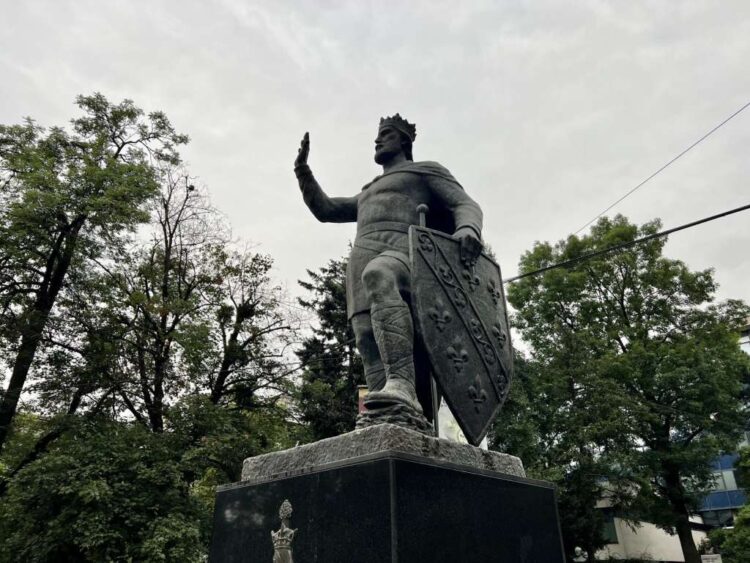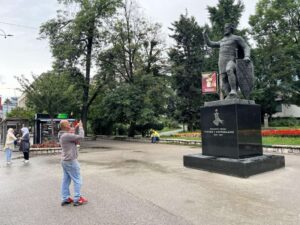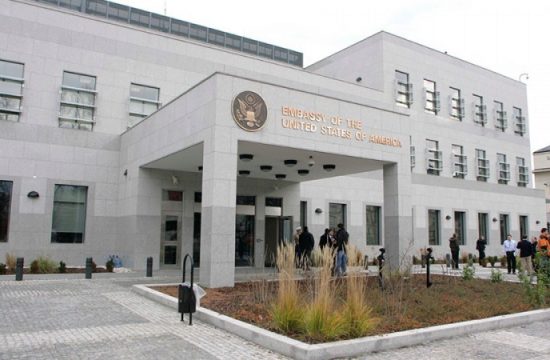
A monument to one of the most famous medieval rulers of Bosnia - King Tvrtko I Kotromanic - was erected in Sarajevo, and today's 834th anniversary of the signing of the Charter of Kulin Ban, the oldest document on Bosnian statehood, was chosen as the opening day of the monument. Pročitaj više
The charter was addressed to the Duke of Dubrovnik, Krvas, and to the citizens of the Republic of Dubrovnik. It is the oldest preserved document that testifies to centuries of Bosnian statehood and one of the oldest state documents among all South Slavic nations.
According to the charter written in the Bosnian Cyrillic script, the Bosnian ruler of that time, Ban Kulin, had promised the people of Dubrovnik full freedom of movement and trading across his country.
Ban Kulin's rule is believed to be the most representative of Bosnia's golden age, which made him a common hero of Bosnian national tales.
Three copies of the document that is often dubbed as ‘Bosnia's birth certificate’ have been saved to date but none of them is in Bosnia.
A copy believed to be the oldest one is in a museum in Saint Petersburg, while two other copies, which the historians claim to be of a more recent date, are in Dubrovnik.
The only sample that can be seen in Bosnia is not original and is displayed in the National Museum of Bosnia and Herzegovina in Sarajevo.
In light of that important anniversary, a monument to Stjepan Tvrtko I Kotromanic, who is considered one of the greatest medieval rulers of Bosnia, was erected in Sarajevo. He left behind a country that was bigger, stronger, more politically influential and more militarily capable than the one he inherited.
He was born around 1338. The son of Vladislav Kotromanic and Jelena Subic, Tvrtko came to the Bosnian throne as a fifteen-year-old boy in 1353 and ruled Bosnia under a Ban until 1377.
King Tvrtko I
His rule in Bosnia during that period was marked by constant conflicts with the Kingdom of Hungary, which wanted to get its hands on the rich Bosnian mines and eradicate the Bosnian Bogomils. Tvrtko I Kotromanic is the first Bosnian ruler to take the title of king. It happened in 1377 near Visoko. During his reign, King Tvrtko I Kotromanic made Bosnia and Herzegovina a respectable European state, which experienced political, cultural and economic expansion.

King Tvrtko I is also special in that he was the first ruler of Bosnia to launch a counter-attack on neighbouring countries after Bosnia had been the target of their attacks for years. Tvrko I was more than successful in his conquests. The campaign to Montenegro ended with the conquest of territories all the way to Kotor. Then he turned towards Serbia and reached Sjenica in today's Sandzak. In Mile, he was crowned as the king of Serbia, Bosnia, Pomorje, Humska land, Donji Kraj, Zapadni Strana, Usora and Podrinje.
At that time, Bosnia was also considered an economic power, which based its economy on rich deposits of gold, silver, lead and other valuable metals. The gold coin that was minted is the best evidence of what kind of economic power it was. Tvrtko's ducat was four times larger than the Ottoman ducat, had 24 carats, was four centimetres wide and weighed 16 grams. This gold coin was also important for its symbolism. On one side was the coat of arms of the Bosnian kingdom, with six lilies and two more lilies on the side, and on the other side was a rampant lion, a symbol of the power of his kingdom. His power is also indicated by the fact that the Republic of Venice, the leading European maritime power, entered his name in the Golden Book of Honorary Citizens.
The Bosnian army also participated in the Kosovo battle on the side of the Serbian prince Lazar, who asked Tvrtko I for help. The Bosnian army won a victory over the Turkish army on the left wing where they fought and returned to their homeland with minor losses. After that, Tvrtko I turned to the conquest of Croatian territories where he advanced all the way to Novigrad, and under his rule were all the Dalmatian islands and cities except Zadar and Dubrovnik.
He died suddenly on March 10, 1391, and was succeeded by his cousin Stjepan Dabisa. Tvrtko I was buried in the Church of St. Nicolas in the Mile neighbourhood near Visoko.





Kakvo je tvoje mišljenje o ovome?
Budi prvi koji će ostaviti komentar!